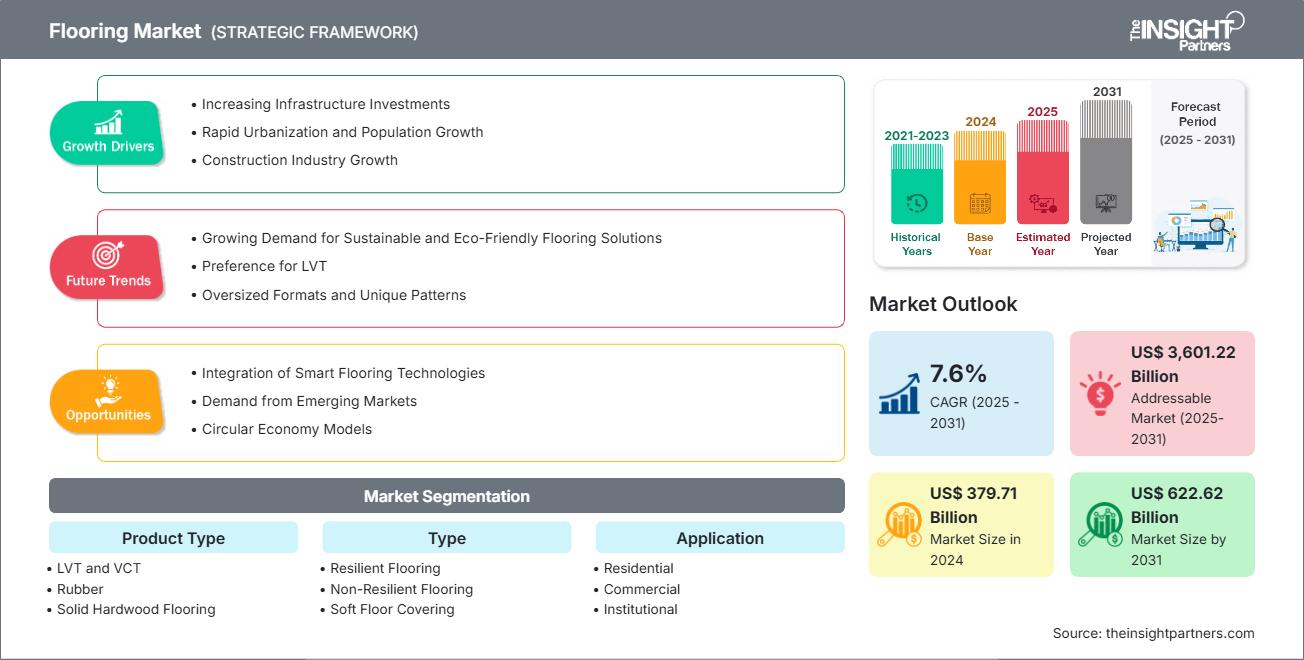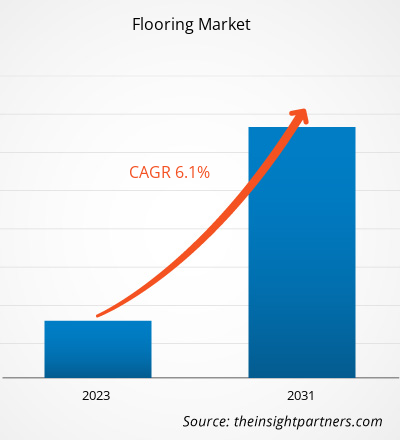地板市场规模预计将从 2024 年的 3797.1 亿美元增至 2031 年的 6226.2 亿美元。预计 2025 年至 2031 年期间该市场的 复合年增长率将达到7.6%。
地板市场分析
全球地板市场正经历着一场动态变革,其影响因素包括消费者偏好的不断演变、快速的城市化进程以及对可持续性日益增长的重视。住宅和商业建筑的需求驱动着市场需求,因为客户寻求符合现代审美趋势的耐用地板解决方案。产品设计的创新和环保意识的提升影响着消费者的选择,导致人们对环保材料的兴趣日益浓厚。技术进步和数字化分销渠道加剧了竞争,促使制造商提供多样化的产品并适应区域需求。
地板市场概况
快速的城市发展、不断变化的生活方式以及对设计和环保责任的日益重视,共同塑造着全球地板市场。随着住宅和商业空间的演变,买家寻求兼具视觉吸引力和实用性的地板选择,以适应各种环境。地板行业正积极响应环保理念的浪潮,提供创新的材料和饰面。强劲的区域增长,尤其是在亚太地区,得益于建筑业的蓬勃发展和现代化程度的提升,以及数字平台简化了消费者获取和选择材料的方式。
您可以免费定制任何报告,包括本报告的部分内容、国家级分析、Excel 数据包,以及为初创企业和大学提供优惠和折扣
地板市场:战略洞察

-
获取此报告的顶级关键市场趋势。此免费样品将包括数据分析,从市场趋势到估计和预测。
地板市场的驱动因素和机遇
市场驱动因素:
-
快速城市化和人口增长:
全球范围内不断增长的城市人口正在刺激对新住宅和商业建筑的需求。 -
建筑业扩张:
由于房主和企业寻求提高美观度和耐用性,发达国家的翻新和改造活动刺激了地板市场的扩张。 -
可支配收入的增加和生活方式的改变:
中产阶级人口的增长、收入的提高以及对家居舒适度投资的增加,提升了对优质、定制和外观吸引人的地板产品的需求,促使制造商扩大豪华乙烯基瓷砖 ( LVT )、工程木材和设计师陶瓷的供应。 -
消费者对美观耐用解决方案的需求不断增长:
人们越来越青睐高品质、美观耐用的地板,例如乙烯基地板、陶瓷地板、复合地板、硬木地板和复合木地板。随着生活水平的提高和可支配收入的增加,这种需求也在不断增长。 -
政府投资和政策:
在许多国家,支持智慧城市发展、基础设施现代化和住房计划的政策加速了对现代地板解决方案的需求。
市场机会:
-
非住宅领域的增长:
随着商业、医疗保健和机构地板行业在发达市场和新兴市场的扩张和现代化,这些行业将面临明显的机遇。 -
采用数字渠道:
电子商务的蓬勃发展使地板公司能够直接接触客户。如今,线上平台为消费者提供了更多机会来比较、选择和购买地板产品,从而降低了许多地区的市场准入门槛,并刺激了整体需求。 -
产品组合多样化:
制造商和供应商可以在其产品线内进行创新,提供专业或利基解决方案,如防水、抗菌或防过敏地板,以满足特定的客户需求或监管要求。 -
战略合作伙伴关系和本地制造:
与当地制造商合作或在高增长地区(如亚太地区)收购土地和设施可以加快产品进入市场和本地化的速度,降低物流成本,更好地满足不同的区域偏好。 -
可持续产品细分:
虽然可持续性是一种趋势,但具体的机会是推出经过认证的环保地板生产线,以满足日益增长的监管和消费者对绿色建筑材料的要求。
地板市场报告细分分析
为了更清晰地了解地板市场运作方式、增长潜力和最新趋势,我们将地板市场划分为不同的细分市场。以下是大多数行业报告中使用的标准细分方法:
按产品类型:
-
LVT和VCT:
LVT 模仿天然材料,而 VCT 是一种耐用、有弹性的瓷砖,常用于人流量大的区域。 -
橡皮:
橡胶地板具有弹性、减震和防滑性能,非常适合健身房和人流量大的空间。 -
实木硬木地板:
实木地板由完全由一整块木材铣削而成的木板制成。 -
瓷砖:
瓷砖由成型的烧制粘土制成,表面有上釉或无釉两种,具有耐用、装饰性。 -
具体的:
混凝土地板经过浇注、养护和加工,为各种应用提供了耐用且多功能的表面。 -
花岗岩瓷砖:
花岗岩瓷砖由天然石材切割而成,以奢华、坚固和独特的图案而闻名。 -
水磨石:
水磨石地板是一种抛光复合材料,使用嵌入水泥或环氧树脂中的大理石或玻璃碎片作为装饰地板。 -
石灰石瓷砖:
石灰石瓷砖具有天然、质地柔软的石材表面,因其独特的化石图案和泥土色彩而备受推崇。 -
大理石瓷砖:
大理石瓷砖采用抛光、有纹理的天然石材,用于打造精致、优雅的地板饰面。 -
地毯和地垫:
地毯和地垫是纺织覆盖物,为地板表面提供温暖、舒适和隔音效果。 -
强化木地板:
强化木地板模仿木材或石材,带有照相层,并由耐用的耐磨表面保护。 -
其他的:
其他部分涵盖利基或新兴地板类型,包括软木、竹子或特种复合材料。
按类型:
-
弹性地板:
弹性地板具有柔韧性和耐用性,包括乙烯基、橡胶或油毡,可用于商业和住宅用途。 -
非弹性地板:
非弹性地板,包括瓷砖、石材和硬木等硬质表面材料,缺乏灵活性。 -
柔软的地板覆盖物:
为了舒适和保暖,柔软的地板覆盖物包括柔韧的纺织品选择,例如宽幅地毯和区域地毯。
按应用:
- 住宅
-
商业的
- 酒店业
- 办公楼
- 其他的
- 机构
- 工业的
按地域划分:
- 北美
- 欧洲
- 亚太地区
- 中东和非洲
- 南美洲和中美洲
随着建筑业的扩张,亚太地板市场依然至关重要。
地板市场区域洞察
Insight Partners 的分析师已详尽阐述了预测期内影响地板市场的区域趋势和因素。本节还讨论了北美、欧洲、亚太地区、中东和非洲以及南美和中美洲的地板市场细分和地域分布。
地板市场报告范围
| 报告属性 | 细节 |
|---|---|
| 2024年的市场规模 | 3797.1亿美元 |
| 2031年的市场规模 | 6226.2亿美元 |
| 全球复合年增长率(2025-2031) | 7.6% |
| 史料 | 2021-2023 |
| 预测期 | 2025-2031 |
| 涵盖的领域 |
按产品类型
|
| 覆盖地区和国家 |
北美
|
| 市场领导者和主要公司简介 |
|
地板市场参与者密度:了解其对业务动态的影响
地板市场正在快速增长,这得益于终端用户需求的不断增长,而这些需求又源于消费者偏好的不断变化、技术进步以及对产品优势的认知度不断提升等因素。随着需求的增长,企业不断扩展产品线,不断创新以满足消费者需求,并抓住新兴趋势,从而进一步推动市场增长。

- 获取地板市场主要参与者概览
地板市场份额按地区分析
亚太地区地板市场正在显著增长。拉丁美洲、中东和非洲等新兴市场为地板供应商提供了尚未开发的扩张机会。
由于建筑活动激增、政府政策以及可支配收入的提高,各地区地板市场的增长情况各有不同。以下是各地区市场份额和趋势的总结:
1. 北美
-
市场份额:
占据全球市场的很大份额 -
关键驱动因素:
- 强大的住宅建设和改造
- 商业部门的增长和外国投资
- 产品多样化和创新
-
趋势:
可持续性和环保材料越来越多地融入到生产和营销策略中。
2.欧洲
-
市场份额:
城镇化和基础设施扩张带来的很大一部分 -
关键驱动因素:
- 欧盟改造浪潮支持改造和重塑
- 欧盟绿色协议推动向可回收、循环材料转变
- 豪华乙烯基瓷砖 (LVT) 和 SPC 通过 DIY 渠道快速渗透
-
趋势:
住宅地板越来越高端化(尤其是在英国),并且越来越注重可持续性,企业和监管机构都强调环保地板
3. 亚太地区
-
市场份额:
增长最快的地区,市场份额逐年上升 -
关键驱动因素:
- 快速城市化和基础设施发展
- 中产阶级不断壮大,可支配收入不断增加
- 智慧城市和大型建设项目投资
-
趋势:
地板销售正在迅速转向数字化和电子商务。随着消费者品味的转变和现代化的推进,模块化和定制化地板正日益受到青睐。
4.中东和非洲
-
市场份额:
市场稳步增长 -
关键驱动因素:
- 城市化和住宅建设激增
- 政府支持的大型基础设施项目
-
趋势:
家庭和企业越来越重视支持能源效率和易于维护的地板
5.南美洲和中美洲
-
市场份额:
尽管规模较小,但增长迅速 -
关键驱动因素:
- 城市化进程加快,中产阶级扩张
- 大规模建设和房地产增长
-
趋势:
增加电子商务在地板购买中的使用,并加大对现代地板替代品优势的宣传力度。
地板市场参与者密度:了解其对业务动态的影响
市场密度高,竞争激烈
由于美利肯公司 (Milliken & Company)、洁福乐 (Gerflor SAS)、得嘉 (Tarkett)、福尔波 (Forbo Holding AG) 和 AHF LLC 等知名企业的加入,竞争异常激烈。此外,区域性和细分市场供应商,包括 Altro Limited(全球/欧洲)、BOEN(亚太、欧洲、中东和非洲)以及 Woodland Floors Ltd(英国),也正在加剧跨地区的竞争格局。
这种激烈的竞争促使公司通过提供以下产品脱颖而出:
- 性能和功能创新
- 专注于环保和可持续产品
- 智能与数字化功能的融合
- 消费者对定制和美学的需求
机遇与战略举措
- 与原材料供应商、分销商和制造技术提供商建立牢固的合作伙伴关系变得至关重要。
- 公司正在探索替代性、可再生材料的战略采购和投资,以帮助他们最大限度地减少原材料成本波动和监管压力的影响。
- 市场领导者投资于在线订购、尺寸定制和库存管理的数字平台,从而简化物流并改善客户体验。
在地板市场运营的主要公司有:
- 美利肯公司(美国)
- Gerflor SAS(法国)
- 得嘉(法国)
- 福尔波控股公司(瑞士)
- 肖氏工业集团(美国)
- AHF LLC(美国)
- Altro Limited(英国)
- 莫霍克工业公司(美国)
- BOEN(挪威)
- Terrain Floorings(阿联酋)
- Interface Inc(美国)
- 东理株式会社(日本)
- Wedge Industries Ltd(印度)
- Mannington Mills Inc(美国)
- Congoleum(美国)
免责声明:以上列出的公司没有按照任何特定顺序排列。
研究过程中分析的其他公司:
- 迪克西集团
- 巴尔塔集团
- 维多利亚有限公司
- 近距离铣刀
- Karndean 设计地板
- 马托尼阿尔弗雷多有限公司
- 尤尼林
- 威克斯
- 豪顿细木工有限公司
- 詹姆斯·哈尔斯特德有限公司
- 帕拉多有限公司
- TrioFlor
- 自由之家
- 多玛地板
- 阿特拉斯协和式飞机
地板市场新闻及最新发展
-
AHF Contract 推出 Nod to Nature LVT
AHF Contract 推出了 Nod to Nature,这是一款全新的豪华黑胶唱片系列,旨在将自然世界的美丽与高性能融为一体。 -
Tarkett 推出全新 True to Form LVT 系列
得嘉 (Tarkett) 推出全新系列“真我”(True to Form),以高端Contour奢华乙烯基瓷砖为基底。“真我”系列融合了Contour结构的耐用性与天然木材和石材的质感,展现了自然界元素的美感与力量。 -
Transom Capital 完成对 Galleher 的收购
Transom Capital Group 宣布完成对 Galleher, LLC 的收购,后者是一家西部地区地板产品分销商和制造商,通过零售、承包商、商业和其他渠道以公司自有品牌和领先的第三方品牌销售地板产品。 -
Tarkett 与 Avery Automats 建立合作伙伴关系,利用回收的 LVT
Tarkett 与位于佐治亚州道尔顿的汽车地毯和全天候地垫制造商 Avery Automats 建立了独特的合作伙伴关系,找到了回收 LVT 的创造性解决方案。 -
Tarkett 推出性能卓越的非 PVC 弹性地板系列
得嘉 (Tarkett) 推出非PVC板材和瓷砖地板系列,彰显了公司致力于帮助企业实现可持续发展目标的全方位解决方案。该系列名为“Collective Pursuit”,是一款高性能解决方案,在尺寸稳定性、抗冲击性和易维护性方面堪比豪华乙烯基瓷砖。这是得嘉北美地区首个此类系列。
地板市场报告覆盖范围和交付成果
《地板市场规模及预测(2021-2031)》报告对市场进行了详细分析,涵盖以下领域:
- 涵盖范围内所有细分市场的全球、区域和国家层面的地板市场规模和预测
- 地板市场趋势以及市场动态,例如驱动因素、限制因素和关键机遇
- 详细的波特五力分析和 SWOT 分析
- 地板市场分析涵盖市场趋势、全球和区域框架、主要参与者、法规和最新市场发展
- 行业格局和竞争分析,涵盖市场集中度、热图分析、知名参与者以及地板市场的最新发展
- 详细的公司简介
- 历史分析(2 年)、基准年、预测(7 年)及复合年增长率
- PEST和SWOT分析
- 市场规模、价值/数量 - 全球、区域、国家
- 行业和竞争格局
- Excel 数据集
近期报告
客户评价
购买理由
- 明智的决策
- 了解市场动态
- 竞争分析
- 客户洞察
- 市场预测
- 风险规避
- 战略规划
- 投资论证
- 识别新兴市场
- 优化营销策略
- 提升运营效率
- 顺应监管趋势






















 获取免费样品 - 地板市场
获取免费样品 - 地板市场